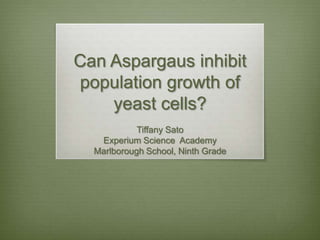Cancercellpwpt udtated
- 1. Can Aspargaus inhibit population growth of yeast cells? Tiffany Sato Experium Science Academy Marlborough School, Ninth Grade
- 2. Hypothesis and Goals ’üČ During digestion, asparagus produces sulfur compounds, which is beneficial in the reduction of the growth of cancer cells (Mitchell, 2001). Therefore, I decided to investigate this further which led me to the information that asparagus produced high levels of sulfur. From this, I decided to start studying the effect of asparagus on yeast activity. ’üČ I wanted to see a decrease in yeast activity compared to a negative and positive control. A decrease in growth meant that the asparagus, the high amounts of sulfur, was inhibiting the growth of the yeast cells.
- 3. Why I used Yeast Cells and the Similarities ’üČ Yeast Cells ’üČ Cancer Cells (Saccharomyces ’üČ Typical eukaryotic cerevisiae) structure ’üČ Typical eukaryotic ’üČ Fast and structure incontrollable cell ’üČ Fast and division incontrollable cell division ’üČ Economically accessible ’üČ Genetic material is known
- 4. Yeast Cells as a Model Organism ’üČ I realized that scientific studies have shown that Saccharomyces cerevisiae could be used as an alternative to cancer cells when doing research. (Hartwell, 2001; Mortimer, 1973)
- 6. Can Asparagus inhibit population growth in yeast cells? Yeast Activity Viable Colony Growth with Counts with Agar Spectrophotometer Plates
- 7. Recipes Positive (YPD+) ŌĆó 1% Yeast Extract ŌĆó 2% Peptone ŌĆó 1% Dextrose Negative (YPD-) ŌĆó Water Experimental (YPDAsp) ŌĆó 1% Yeast Extract ŌĆó 2% Peptone ŌĆó 1% Dextrose ŌĆó 50mL of Filtered Asparagus
- 8. Yeast Activity Growth with Spectrophotometer Grow S. cerevisiae Centrifuge all Incubated all in YPD+, YPD-, the different cultures for 24 hours YPDAsp Broths mediums Measured the absorbance of each using a Compared the Yeast spectrophotometer at Activity Growth Results 600nm
- 9. Viable Colony Counts using Agar Plates For my agar Streak onto my plates, I three different inoculated a Incubate for 48 plates: positive, colony from a hours at 30oC colony off a negative and positive plate. experimental Record Viable Incubate for 24 Colony Count hours at 30o C Results
- 10. Results for Yeast Growth Activity
- 11. Absorbance of Yeast Activity Sample 1 0.9 0.8 Absorbance (600nm) 0.7 0.6 0.5 POSITIVE 0.4 NEGATIVE 0.3 EXPL 0.2 0.1 0 0 5 10 15 Sample Numbers
- 12. Data Table
- 13. Data ’üČ Average for Negative (without any nutrients) : 0.189 abs ’üČ Average for Experimental (with asparagus): 0.488 abs ’üČ Average for Positive (with nutrients, without asparagus):0.633 abs
- 14. Conclusions for Yeast Growth Activity ’üČ My results from my experiment with the liquid medium with asparagus had the lowest absorbance (0.488 abs) compared to my positive control (0.633 abs ) and higher absorbance compared to my negative control (0.189 abs). This indicates a decrease in yeast activity upon addition of asparagus indicating minimal cell growth.
- 15. Results for Viable Colonies
- 17. Comparison of the Controls Negative Experiment Positive Experiment
- 18. Conclusions from Viable Colonies ’üČ Although viable colonies have limited quantification, the pictures show the apparent difference of structural colonies between the Positive, Experimental, and Negative. Positive Experimental Negative ŌĆó Raised, Convex ŌĆó Flat Surface ŌĆó Produced no Surface colonies
- 19. Acknowledgements Thank you to Sigma Xi for this opportunity. Thank you to RaudhahRahman, Experium Science Academy, my parents, and those who have supported me throughout.


















